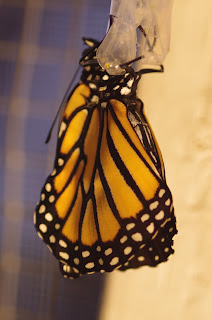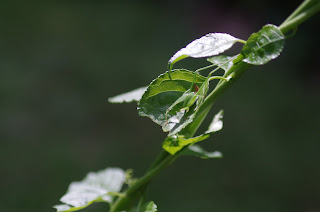The monarch:
This is what it looked like when I got up at 6 a.m.
I don't know what time this is, but it's a couple of hours later. See the vertical line of gold dots? The expansion joint above that has expanded...
... and later, the expansion joint above that...
Meanwhile, I waited 4 hours and 45 minutes, watching these two gorge themselves, and then...
The body is basically bloated with liquid, and it contracts to pump that liquid into the wing veins (or whatever they are), expanding the wings. Eventually it will expel any extra liquid, but first the wings have to be expanded. You can also see the proboscis, which starts out as two sides that are sort of zipped together into one, but you can't really see that in the pictures.
The wings are fully expanded, which may not be the right word. This is a female. The males have a dark dot on their hindwings, which the female does not have.
At this point in the process I went outside to do my bug walk, leaving her to dry her wings. After my bug walk I took her outside. She wasn't ready to fly yet, her wings were still damp, so I just sat with her for quite a while as she crawled around on my hand. This gave me a good chance to get a close look at her.
Monarch butterflies belong to the family Nymphalidae, the brush-footed butterflies. I guess I can see why they are called that.
Eventually I transferred her to a flower, making sure that it didn't have any spiders or ambush bugs on it. The flower did gt other visitors, though.
I didn't stick around to see her fly for the first time; I had some other things to do, and was really dragging from a lack of sleep, due to getting up at dawn to wait for this beauty to emerge.
I'd like to mention here that today was mostly about insects teasing and being uncooperative. First there was the butterfly who kept me waiting almost five hours for her to emerge. Then there were the two caterpillars who were ready to pupate, and could have done so at any time in those 5 hours and I would have seen it, but one did it while I was out on my bug walk, and the other did it when I took the butterfly outside. When I went out for my bug walk a huge dragonfly buzzed over my head and then landed in a tree, about 12 feet up. There is a particular kind of fly that I always see once, on a day in August, on the mailbox post, and I saw it today, but before I could take its picture it took off, flew a few laps around my camera(!) and flew away. And then there were all the uncooperative butterflies...
One of those butterflies is nonetheless Backyard Bug of the Day:
The pictures I got don't really justify Backyard Bug of the Day status, but I chose it anyway because it's a rare one for me. The poor pictures are part of the reason I don't have a positive id for it, but the irony of that is that it might possibly be a question mark butterfly. It does a very convincing impression of a hanging dead leaf.
The question mark butterfly and the comma butterfly look very, very similar. In fact, I found a website that compares the two of them, and I couldn't even distinguish the differences on the comparisons on the site. It seems more likely to be a comma based on the fact that it is more common around here (according to that site), but it does look more like the question mark. [Edit: it has been a little over a year since I wrote this post, and in the meantime I have learned the difference between the question mark and comma butterflies, and can confirm that this is a question mark].
Complicating the identification further, apparently there are two generations each year, and based on the time of year their coloring is different. So not helpful.
It's beautiful, though.
And as for another uncooperative butterfly:
Horrible picture of a red-spotted purple. I keep trying, but it keeps flying.
I should probably start back at the beginning of the day, which was actually last night (but after midnight, which makes it today for the purposes of this blog), when I found this on the bathroom wall:
Grape leaf folder moth
The snowberry clearwing hummingbird moth egg has changed color; it was light blue when it was laid on Tuesday, and now it is green.
I think these are green lacewing eggs.
Beetle on purple cone flower
Primrose moth on evening primrose. These bloom in the evening (hence, the name), and tend to look a little wilted by the next afternoon when I am doing my bug walk, but I always check them out to see if there is a moth inside.
I almost walked right by without noticing this:
Katydid
The wasps in the hold seem to be building a paper nest.
While I was looking at them I noticed something else crawling around in the hole...
One of the wasps noticed, too.
Dragonfly
I found another caterpillar overcome by that weird... something. Life's rough for caterpillars. Sometimes I think it's a miracle I ever see any butterflies at all.













































No comments:
Post a Comment